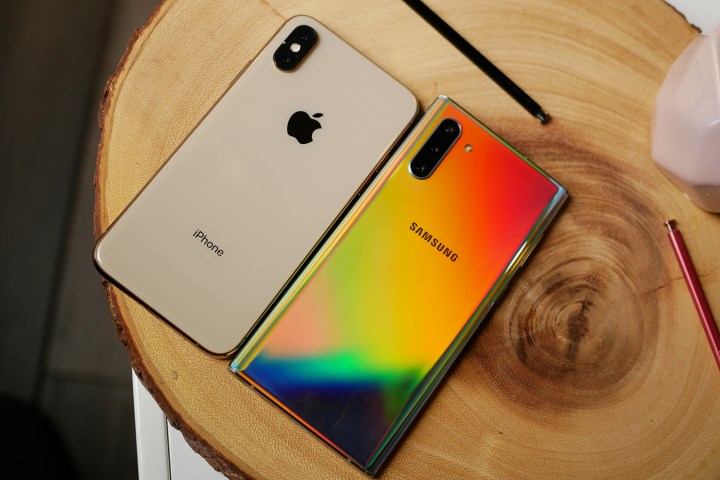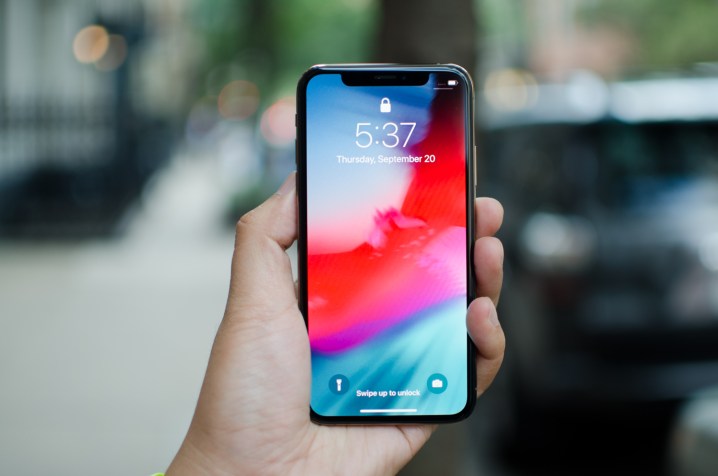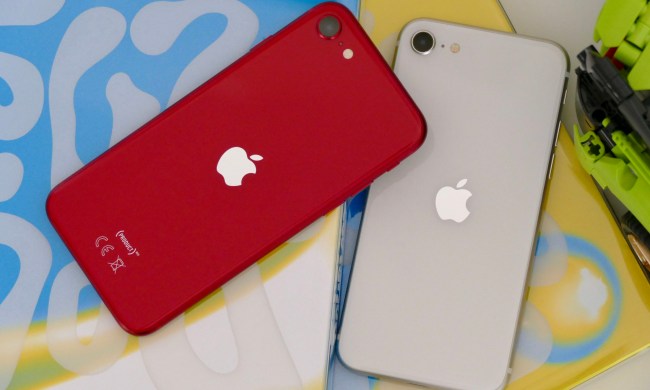
The Samsung Galaxy Note 10 is the smaller sibling to the Note 10 Plus, much in the same way the iPhone XS is the more compact version of the iPhone XS Max. Both of these phones cost close to $1,000 and are meant to pack the best of the best in more reasonably sized packages. But unlike the flagship iPhone range, there are some step-downs from the bigger Note 10 Plus to the Note 10.
Can the brand new Note 10 still edge out the nearly year-old iPhone XS even with these downgrades? We put them in a specs comparison head-to-head to find out.
Specs
| Samsung Galaxy Note 10 | iPhone XS | |
| Size | 151 x 71.8 x 7.9 mm (5.94 x 2.83 x 0.31 inches) | 143.6 x 70.9 x 7.7mm (5.65 x 2.79 x 0.30 inches) |
| Weight | 168 grams (5.93 ounces) | 177 grams (6.24 ounces) |
| Screen size | 6.3-inch Dynamic AMOLED | 5.8-inch Super Retina HD OLED True Tone display |
| Screen resolution | 2280 × 1080 pixels (401 pixels per inch) | 2436 x 1125 pixels (458 pixels per inch) |
| Operating system | Android 9.0 Pie | iOS 12 |
| 256GB | 64GB,128GB, 256GB, 512GB | |
| MicroSD card slot | No | No |
| Tap-to-pay services | Google Pay, Samsung Pay | Apple Pay |
| Processor | Qualcomm Snapdragon 855 | Apple A12 Bionic |
| RAM | 8GB | 4GB |
| Camera | Triple-lens, 16-megapixel, ultra-wide-angle; 12MP standard; and 12MP telephoto rear, 10MP front | Dual 12MP (with dual OIS) rear, 7MP TrueDepth front camera |
| Video | 2160p at 60 frames per second, 1080p at 240 fps, 720p at 960 fps | 4K at 24, 30, or 60 fps. 1080p at 30, or 60 fps. OIS. |
| Bluetooth version | Bluetooth 5.0 | Bluetooth 5.0 |
| Ports | USB-C | Lightning connector |
| Fingerprint sensor | Yes, ultrasonic in display | No |
| Water resistance | IP68 | IP68 |
| Battery | 3,500mAh
QC2.0, AFC, PD3.0 Qi, Fast wireless charging 2.0 |
2,658mAh
Fast charge capable (Additional charger needed) Qi wireless charging |
| App marketplace | Google Play Store | Apple App Store |
| Network support | T-Mobile, AT&T, Verizon, Sprint | T-Mobile, AT&T, Verizon, Sprint |
| Colors | Aura Glow, Aura White, Aura Black | Silver, Space Gray, Gold |
| Price | $950 | $1,000 |
| Available from | Samsung | Apple |
| Review score | Hands-on review | 4.5 out of 5 stars |
Performance, battery life, and charging

With high prices comes high specs — some of the highest, in fact. Samsung has equipped the Note 10 with the latest Qualcomm Snapdragon 855 processor and 8GB RAM, which will handle almost any task you throw at it with relative ease and fluidity.
But Apple’s iPhones have made a name for themselves on speed and fluidity. The A12 Bionic chip inside the iPhone XS has outperformed the SD855 in most benchmark tests since its release, specifically in single-core tests, reasserting, as it does every year, that the iPhone’s seamless integration from hardware to software produces a user experience more than capable enough for anyone. Still, most people won’t see much of a difference in day-to-day performance between these two phones.
The Note 10 has an edge in battery capacity, sporting a 3,500mAh juice pack compared to the iPhone’s 2659mAh power source. In real-life, day-to-day use, you’ll get about a day’s use from both of these devices, but even with the bigger battery, expect the Note 10 to charge up quicker with its bundled 25-watt charger. Samsung said this will juice the Note 10 up from zero to 100 in about an hour, which is a pretty big leap from the iPhone’s 5-watt adapter and its nearly three-hour charge time.
Unfortunately, the Note 10 doesn’t support 45-watt charging as its bigger sibling, the Note 10 Plus, does. The iPhone XS can accept up to an 18-watt charger, which cuts charge time down much closer to an hour. Both support wireless charging.
Neither phone is going to let you down in crunch time, multitasking, gaming, or otherwise throughout a day’s use, but the iPhone XS smoother performance will prove a better hardware solution over time.
Winner: iPhone XS
Design and durability
Neither phone has a headphone jack anymore, so let’s just throw that out there right now, and neither phone carries a dongle in the box.
When it comes to the looks of these phones, we’re looking at two different, yet decidedly futuristic aesthetics. The iPhone XS is made of stainless steel and “durable” glass, whereas the Note 10 sticks with aluminum and Gorilla Glass 6. It means the iPhone XS will fare better in the event of drops, and won’t see as many scratches.
The iPhone XS differs in its bigger metal edges and bezels, whereas the Note 10 employs a thinner, more rounded curve on its glass sides, meeting a thinner sliver of the metal casing. This and the iPhone’s notch versus the Note’s punch-hole cutout for the selfie cam are the most immediate differences. Oh, and the beautiful Aura Glow color the Note 10 offers.
Otherwise, the two devices are nearly the same footprint, with the Note 10 just being about a third of an inch taller, but not as heavy. The Note 10 also fits in a half-inch more screen in its frame due to the extremely slim bezels. These slimmer bezels do mean less protection from drops, but expect either of these phones to shatter from a nasty drop.
Beauty is in the eye of the beholder, but Samsung wins this round for its increasingly futuristic design and refinements.
Winner: Galaxy Note 10
Display

These are two gorgeous phone displays with excellent color accuracy and tuning.
The iPhone XS’s OLED 5.8-inch display tries to look its best for you depending on the lighting you’re in with its True Tone display feature enabled, but otherwise doesn’t offer much tweaking aside from the Night Shift option to lower blue light. It’s a well-colored display that changes its hues adeptly and subtly in various lighting, lessening the need for screen modes to tweak.
The Dynamic AMOLED display on the 6.3-inch Note 10 is equally excellent, and the one on the Note 10 Plus is specifically the most accurate display DisplayMate has ever tested. But that’s the Plus model. The smaller Note 10 doesn’t have the same resolution, but should otherwise be the same. It also has a few color modes to choose from, as well as a blue-light filter.
The pixel density and screen resolution on the iPhone XS (459 pixels per inch, 2436 x 1125, respectively) are higher than the Note 10 (400 PPI, 2280 x 1080), but the difference may not be noticeable to most people. You are getting a bigger screen on the Note 10 without a dramatically bigger difference in footprint.
It’s a very close test here, but we’re giving the edge to the iPhone XS for the sharper screen.
Winner: iPhone XS
Camera

With a triple-camera setup in the back, the Note 10 Plus has a 16-megapixel, wide-angle camera over the iPhone XS, enabling more encompassing shots. But the XS and Note 10 both have 12-megapixel regular and telephoto cameras with similar apertures, though the Note does have mechanical variable aperture on its main shooter for better low-light photography.
The Note 10 also has a dedicated night mode for both the front- and rear-facing cameras. We’ve seen the Galaxy S10 produce some better results in low-light over the iPhone XS, due in part to the variable aperture, and night mode is likely to increase that disparity.
Up front, we have a 10-megapixel selfie cam on the Note 10 up against the iPhones 7-megapixel front-facer. Both have dedicated portrait modes, but the iPhone’s uses additional hardware to achieve its blur application, whereas the Note relies on software only.
Both are excellent camera phones, but the Note 10 edges for better low-light photography and more versatility, thanks to the wide-angle lens.
Winner: Note 10
Software and updates

In the duel between Samsung’s One UI (built on Android 9 Pie) versus iOS 12, there’s no question you’ll get more updates over time and receive them on a clearer, more regimented schedule with the iPhone. iPhone’s, on average, receive around four or five years of software updates, whereas Samsung devices are notoriously slow to receive updates and last around two to three years.
iOS vs Android is its own philosophical and stylistic debate, but it’s always been Android’s biggest challenge to match the polish and support of iOS. If longevity is your goal, the iPhone will be more current for much longer than the Note 10.
Winner: iPhone XS
Special features

Samsung’s One UI is a feature-heavy OS, and the Note 10 plus adds a few key features to this. First is the S Pen, which in addition to taking notes and controlling music, can now transcribe handwritten notes into Microsoft Word documents and control the Note 10’s camera.
Introduced on the Note 10 is deeper integration with Microsoft Windows, which allows you to see receive messages, notifications, and soon phone calls from your Note 10 on your Windows device. Microsoft already has an app called “Your Phone” which enables such functionalities, but Samsung’s integration adds phone mirroring and interactions through which, as well.
Galaxy Play Link promises further support between your Note 10 and PC with the ability to stream PC games directly from your computer to your Note 10 device — a feature likely best used on a 5G phone, like the bigger Note 10 Plus 5G, and the select few people who have access to such services in the U.S. — but this feature isn’t available yet. DeX mode also adds some functionality, now able to launch on a Mac or PC by only connecting a USB-C cable.
But taking hand-written notes on a phone is still a relative niche desire, as is DeX support, so when it comes down to universally usable features like computer support, the Note 10 can’t compare to the iPhone XS. With extremely seamless handoff support between Macs and iOS devices, users can resume webpages, text messages, emails, and take video and audio calls from the iPhone on their Macs.
Winner: iPhone XS
Price
The Note 10 is priced at $950 and comes in just a 256GB configuration with no expandable memory, unlike the Note 10 Plus, which offers more size options and MicroSD card support. The iPhone XS starts at $50 more for $1,000 with 64GB storage and has 256GD and 512GB options for $1,150 and $1,350, respectively.
Bear in mind that with a new iPhone due this fall, you can likely find all of these for less.
Overall Winner: iPhone XS
The Note 10 is a gorgeous, powerful, and sleek device. But making it the less powerful Note device, with only one storage option and no way to expand, makes this niche device even more so. Taking notes on a phone isn’t a compelling enough sell over the iPhone’s solid, steady performance, and unrivaled ecosystem. Camera enthusiasts may find the Note 10 a better option for photography, but with a new iPhone only a month or two away, the Note 10 may not reign over the iPhones in this category much longer.





